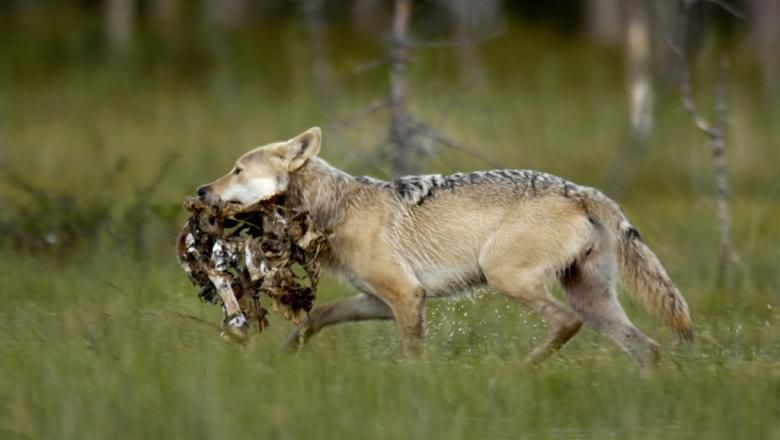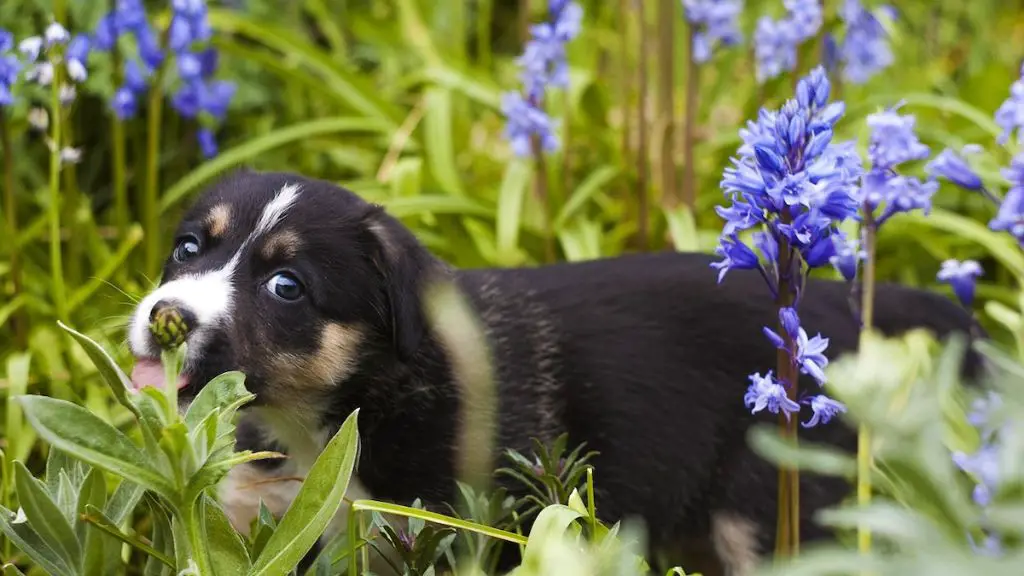Ancestral Diet

Before domestication, dogs and their ancestors like wolves subsisted on a primarily carnivorous diet. As pack animals, wild canines would hunt together to take down large prey like deer, elk, and bison. They would also scavenge for leftover carcasses from other predators. The presence of starch granules on fossilized teeth shows wild canines consumed some plant foods as well, likely opportunistically foraging for berries, roots and grasses. But meat from hoofed mammals provided the bulk of their nutrition and calories. Unlike omnivorous bears that can switch between plants and meat depending on availability, wild canines are hypercarnivores, meaning over 70% of their diet consists of animal flesh. This meat-based ancestral diet provided the proteins and fats wild canines needed to survive and thrive as athletic hunters and constant roams traveling large territories.
Scavenging
Before domestication, dogs were scavengers that relied on finding leftover remains from kills made by other predators. As opportunistic omnivores, dogs would eat whatever food they could find, which often meant scavenging. Their excellent sense of smell allowed them to locate rotting carcasses from miles away. Dogs retain this natural tendency today. When left to fend for themselves, stray and feral dogs will scavenge through trash and waste to find scraps of food. They have resilient digestive systems that allow them to consume foods that would make other animals sick. A dog’s scavenging ability is one reason the species has thrived across various environments worldwide.
Scavenging provides dogs an efficient means of survival without needing to hunt prey themselves. However, it’s not without risks. Competition for limited food sources and fights with other scavengers over carcasses were common. Eating spoiled meat also exposes dogs to potential illnesses. But their evolutionary adaptations made dogs highly effective scavengers able to derive sustenance from sources other animals can’t.
Hunting
One option for dogs without human care would be hunting small prey. While dogs today are primarily pets relying on humans for food, their wolf ancestors were skilled hunters who worked together in packs to take down animals like deer, rabbits, and rodents. If left to fend for themselves, some dogs may rediscover their innate hunting abilities.
Certain dog breeds like terriers and hounds have strong prey drives and retain superior senses of smell and hearing that would aid hunting. Fast, agile breeds like greyhounds could use their speed to run down prey. Even small dogs may be able to catch mice, voles or birds if hunting in groups. With practice and experience, dogs could learn strategies like flushing animals from hiding and ambushing as a coordinated pack.
However, not all dogs have the appropriate traits or temperament for successful hunting. Modern breeding has reduced prey drive in some dogs. Others may struggle due to lack of training from a young age or physical limitations like brachycephalic (“flat-faced”) breeds who have trouble breathing. Without humans, dogs would need to quickly adapt to survive. Those able to tap into their ancestral hunting skills would have an advantage catching their own food.
Foraging
Dogs have retained some natural foraging instincts from their wolf ancestors. Wolves are omnivores and will consume berries, fruits, grass, mushrooms and other vegetation in the wild. Dogs have a similar capacity to identify edible plants and fungi. Their excellent sense of smell assists them in locating truffles and mushrooms growing underground. However, a dog’s ability to find sufficient nutrition through foraging alone tends to be limited without human assistance. They lack the detailed botanical knowledge of wild omnivores like bears to safely identify abundant edible plants. Nonetheless, dogs exhibit an intuitive ability to occasionally snack on grass, leaves, berries and fungi during walks. Their flexible diet allows them to extract some nutritional value from foraged vegetation.

Garbage
Garbage and food waste produced by humans can be an important source of food for dogs. In urban areas, stray dogs and feral dogs often scavenge through trash cans, dumpsters, and landfills to find something to eat. Packs of dogs may congregate around dump sites or locations where garbage is frequently discarded.
A dog’s sense of smell allows them to sniff out even small bits of edible food mixed in with the waste. They are willing to eat scraps of meat, bones, grains, vegetables, paper and food containers if sufficiently hungry. Certain dogs even specialize in searching for and consuming food garbage as their primary means of survival.
This dependency on refuse from humans can introduce health risks to dogs from eating spoiled, toxic or indigestible food. However, access to human garbage provides a vital source of calories for dogs living on the fringe of human settlements. Without this food source, many stray and feral dogs would suffer from malnutrition or starvation.
Catching Fish
Dogs have a natural ability to catch fish in rivers, streams, and other bodies of water. Their keen eyesight allows them to spot movement in the water, and their quick reflexes enable them to snatch fish swiftly. Certain breeds like Labrador Retrievers and Newfoundlands were originally bred to retrieve fish for fishermen. Their partially webbed paws give them an advantage for swimming after prey.
When living in the wild, dogs have been observed wading into streams and waiting patiently for a fish to swim by. They use their rapid bite to catch the fish before it can dart away. Their powerful jaws allow them to maintain a firm grip on slippery fish once caught. Dogs have even been known to work cooperatively to herd fish into shallower areas and trap them more easily.
Without humans providing regular meals, dogs would rely more on their natural fishing abilities to survive. Catching fish from rivers and streams would become an important skill for finding food. This highlights dogs’ resourcefulness and adaptability when forced to fend for themselves and survive on whatever food sources are available.
Cooperation
Dogs are pack animals by nature and will cooperate to find food in the wild. Their ancestors, wolves, typically hunt in coordinated packs to take down large prey like elk or bison. While dogs today don’t usually hunt such large animals in the wild, they can still work together to catch smaller prey or forage for food.
When hunting, dogs will take on different roles within the pack. Some may act as “chasers” to run down prey while others lie in wait as “ambushers.” The chasers will pursue an animal and herd it towards the ambushers for the kill. Each dog plays a part for the success of the pack.
For foraging, dogs may also split up to cover more ground when searching for food. They will fan out to sniff around for anything edible, whether berries, small animals, eggs, or carrion. If one dog finds a substantial source of food, he may return to the pack to alert the others. By working together and sharing information, the dogs improve their chances of finding meals.
The cooperation seen in packs of feral dogs demonstrates how dogs are still equipped to collaborate even without humans, drawing on their innate social instincts and hunting strategies.
Adaptation
Domesticated dogs have evolved to live alongside humans for thousands of years. While some dogs live as pets and are provided food by their owners, others survive by scavenging. Dogs are highly adaptable and can survive on a wide variety of foods. Over many generations, dogs may evolve and adapt to obtain nutrition from whatever food sources are available in their environment.

Feral dog populations that live independently of humans demonstrate the adaptability of dogs. These dogs survive by hunting small prey, eating discarded human foods, and foraging. Morphological studies of feral dogs show changes compared to domesticated pet dogs, including larger teeth for capturing prey and stronger jaw muscles for cracking bones. Behavioral studies also reveal increased cooperative hunting and foraging skills in feral dogs.
If dogs needed to survive without direct provision of dog food from humans, natural selection would favor those with adaptations allowing them to thrive on whatever food sources are available. Dogs may evolve better skills and physical features for hunting, foraging, fishing, or digesting diverse foods over generations without domestic care. However, their close co-evolution with humans means dogs are highly flexible and may find innovative ways to adapt.
Dangers
Lacking access to human food and care, feral dogs face a host of dangers in trying to find sources of nourishment on their own:
Disease
Scavenging food from trash bins and other sources exposes dogs to harmful bacteria, viruses, and parasites. Without proper veterinary care and medications, dogs have a higher risk of suffering from various illnesses.
Injury
Attempting to hunt prey or forage in the wild increases a dog’s risk of injury from falls, encounters with larger predators, territorial conflicts with other dogs, and automobile accidents in urban settings.
Starvation
Feral dogs often endure cycles of famine and feast. During seasons when prey is scarce or foraging yields little, dogs can face malnutrition and starvation without a steady source of food from humans.
Weather Extremes
Without shelter and care from humans, dogs are vulnerable to heat, cold, storms, and other environmental threats. Extreme weather and lack of refuge can lead to hypothermia, heat stroke, and death.
Poisons
Scavenging human garbage may expose dogs to poisons, toxic chemicals, or tainted food. Ingesting these substances can cause severe illness and death without proper medical treatment.
Bond With Humans
Dogs first started living with humans over 15,000 years ago. At that time, humans were hunter-gatherers who lived a nomadic lifestyle. As humans traveled around to find food, scavenger dogs started following them to eat the scraps left behind. This easy access to leftover food motivated the dogs to continue tagging along with the humans.

Gradually, the humans realized the dogs could assist them in hunting. The dogs’ superior sense of smell helped track prey, while their speed and agility helped corner the animals during the hunt. Humans would reward the helpful dogs with food, further strengthening their bond.
This mutually beneficial relationship allowed both species to thrive. Humans gained loyal hunting partners, while dogs secured a steady food source. Over thousands of years of evolution together, dogs became domesticated and humans transitioned to a more settled agricultural lifestyle.
Today, our intertwined evolutionary histories remain evident through the strong social connection dogs and humans share. This enduring bond originated long ago around their shared meals and continues to be reinforced through the food humans provide their canine companions.